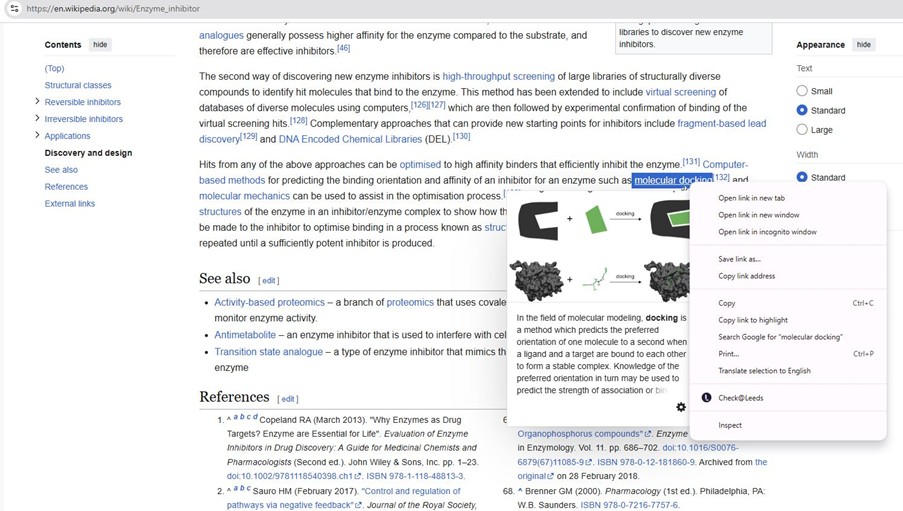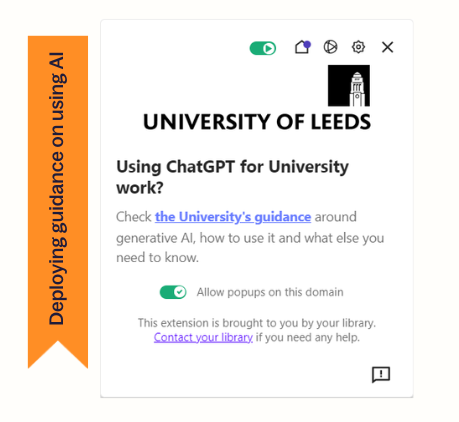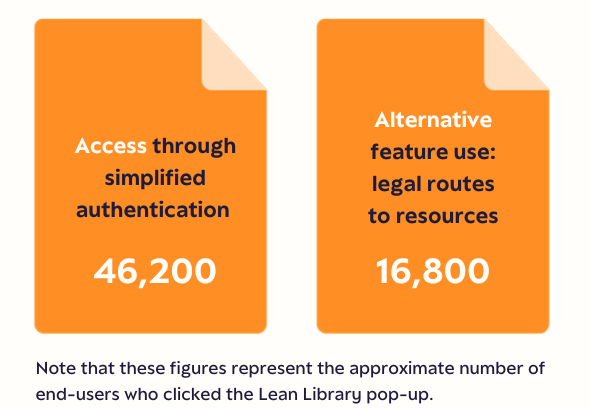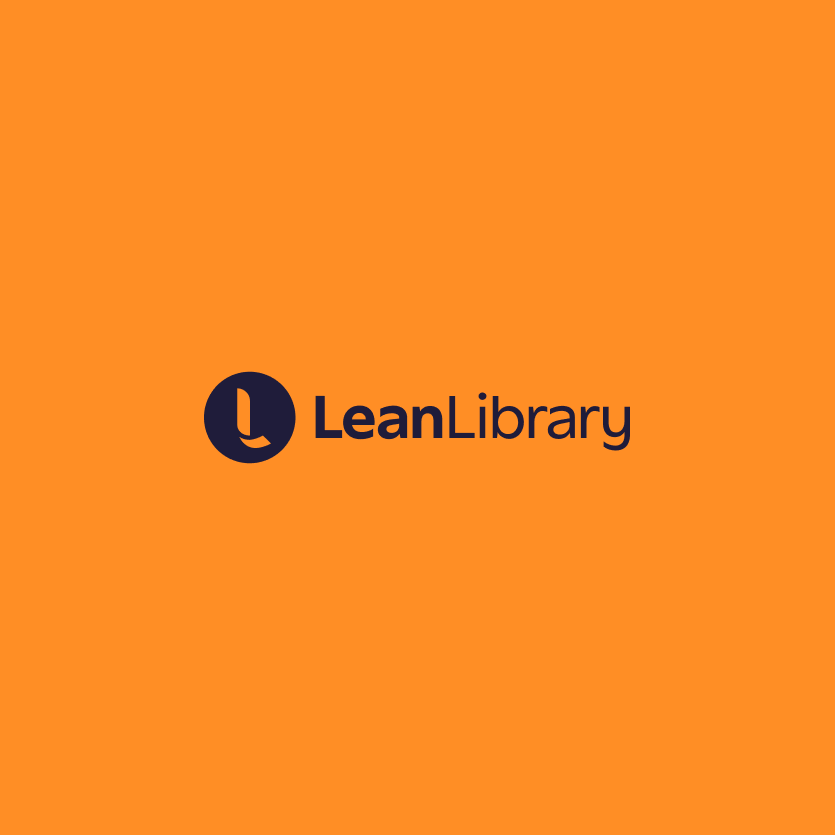Lean Library Case Study: University of Leeds
Ensuring Discovery Beyond the Library Catalogue with Lean Library
Posted 9th September 2025
Posted 9th September 2025

Established in 1904, University of Leeds is one of the largest universities in the UK. They are part of the Russell Group of research-intensive universities and have more than 37,000 students currently studying at the institution.
The university faced a common challenge which many university libraries experience: how to ensure students are aware of library-subscribed content and collections even when they begin their research outside of the library discovery, for example, on sites such as Google Scholar and ChatGPT.
What challenges was your library facing before using Lean Library?
“While undergraduate students made frequent use of our main discovery service, a significant number of postgraduate researchers accessed content through other routes and were therefore often unaware of the library’s owned and subscribed content.
Lean Library helped us address this issue by integrating with the user’s workflow, quickly revealing and providing access to library-owned and subscribed materials, regardless of where the user began their search.”
– Alison Hazelaar, Access & Acquisitions Manager: Metadata & Discovery at University of Leeds Libraries.
In 2024 University of Leeds implemented Lean Library, a library tool which integrates library collections and services directly into student online workflows via the browser extension, to embed library guidance and library-subscribed content wherever the student is in their research journey. This not only makes it easier for students and researchers to easily access the wealth of resources available to them but promotes the library throughout user workflows.
University of Leeds have maximised Lean Library features including Assist Messages, Advanced Library Search (ALS) and Print Alternatives, to further amplify the library’s value and more deeply communicate messages to students.
Which is your favourite feature you have implemented and why?
“One of our favourite features has been the use of Assist Messages which we have added to several websites to offer guidance to users. One example is the Assist Message pop-up which allows the user a link to check the Universities guidance around Generative AI and how to use it.
Check@Leeds, allowing users to highlight a word or topic on any website and search Leeds holdings from there has also been a big hit!”
– Alison Hazelaar, Access & Acquisitions Manager: Metadata & Discovery at University of Leeds Libraries.

Figure 1: Screenshot of Check@Leeds which allows users to highlight a word or topic on any website and brings them to University of Leeds holdings.
University of Leeds have set up Assist Messages across the AI websites which students visit the most including: Perplexity, Claude, Copilot and ChatGPT. Assist Messages about AI guidance have the highest amount of views (nearly 8,500 views across these messages) amongst students compared to other types of Assist Messages. This shows that library advice on using AI is impactful and needed amongst students at the point-of-need.

Figure 2: University of Leeds Assist Message which advises students on the University’s guidelines around Generative AI when they visit the ChatGPT website.
Find out more about how libraries can deploy AI guidance to students here.
University of Leeds have also utilised Additional Library Search (ALS) to brings the power of their library discovery service to Google – where many students begin their search for research. Students can pull their library’s discovery search results into their Google and Google Scholar search result page via the Lean Library extension to discover more content from their library.
Additionally, University of Leeds have seen great usage of the Access and Library Alternatives features amongst their students. The Access feature simplifies access to eResources the library subscribes to, whilst Library Alternatives connects users to alternative resources in the library’s holdings when they hit paywalled resources online.

Figure 3: University of Leeds Access and Alternatives feature use amongst students using Lean Library in 2025.
The Print Alternatives feature, a new enhancement to Lean Library’s existing Alternatives feature, seamlessly surfaces the library’s print book availability when users search for books online. University of Leeds was the first adopter of the Print Alternatives feature and are excited about what this means for increasing usage of library print collections with the library commenting “It is just getting better”. This enables institutions to maximize the impact of their print collections alongside digital offerings.
Read more about the Print Alternatives feature here.
Implementing Lean Library at University of Leeds has ensured discovery of both library-subscribed content and legal, Open Access papers for students whether they begin researching outside of the library or via the library catalogue.
“We had existing data that showed that we’re slightly unusual in having users who do start with our library search but now we’re better able to meet the needs of those users who were starting their search journeys elsewhere. It’s another string to our discovery bow!”
– Alison Hazelaar, Access & Acquisitions Manager: Metadata & Discovery at University of Leeds Libraries.
Since adopting Lean Library in August 2024, University of Leeds have 600 engaged monthly users using Lean Library.
This has been increasing consistently since February 2025 due to targeted outreach efforts from the library earlier this year:
How did you promote Lean Library at your institution to users?
“We’ve promoted Lean Library through three main channels:
• Intra-Library Outreach where we introduced and demonstrated Lean Library to library colleagues, including a full All staff meeting. We have given tailored presentations to specific teams, addressing their questions and sharing promotional materials.
• Faculty Outreach with sessions held with academic and postgraduate colleagues to discuss LL as an alternative access option.
• Communications Support via The Library Communications team who launched a dedicated webpage in January 2025, followed by a full campaign in February. This campaign used news stories, banners, social media posts, and digital displays.
• The publisher negotiations that were happening from 2024 into 2025 also provided another helpful push as we were able to recommend Lean Library to affected departments to highlight how they could still access a wide range of research articles.”
– Alison Hazelaar, Access & Acquisitions Manager: Metadata & Discovery at University of Leeds Libraries.

Do you have any feedback from students or users at your institution?
“We have mostly been letting the statistics do the talking in this first year of having Lean Library. We have exceeded our projection for sign-ups and we now concentrate on the active user metric to show that it’s still very much being used.
User experience is very important to us and, as we move into year 2 [of using Lean Library], we will be thinking about how we can gather first-hand feedback from users.”
– Alison Hazelaar, Access & Acquisitions Manager: Metadata & Discovery at University of Leeds Libraries.
What are you looking to do next with Lean Library?
“We are looking forward to promoting Lean Library Workspace to help users organise and manage both their reading and research in one single place. We’re also excited to learn more about the one One-Click to PDF widget which provides instant access to PDF versions of articles.”
– Alison Hazelaar, Access & Acquisitions Manager: Metadata & Discovery at University of Leeds Libraries.
Find out more about Lean Library.
If you’d like to hear more or receive a product demo, get in touch.



